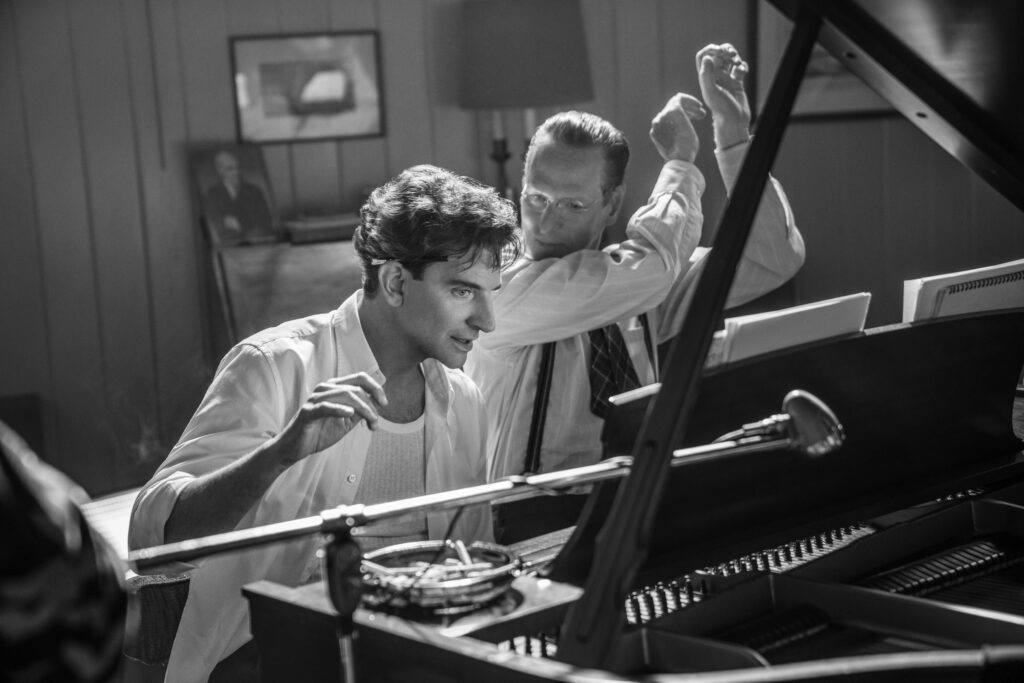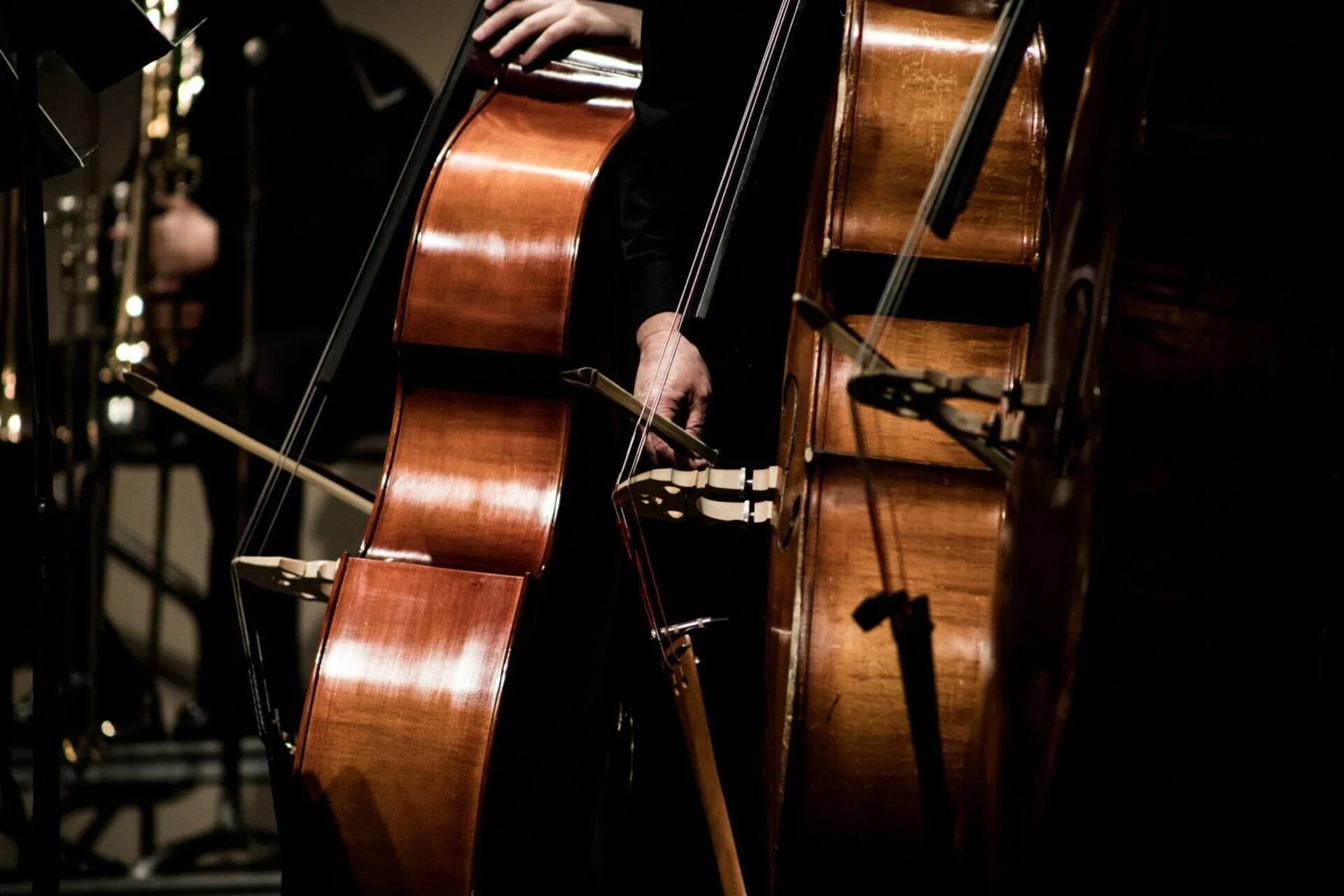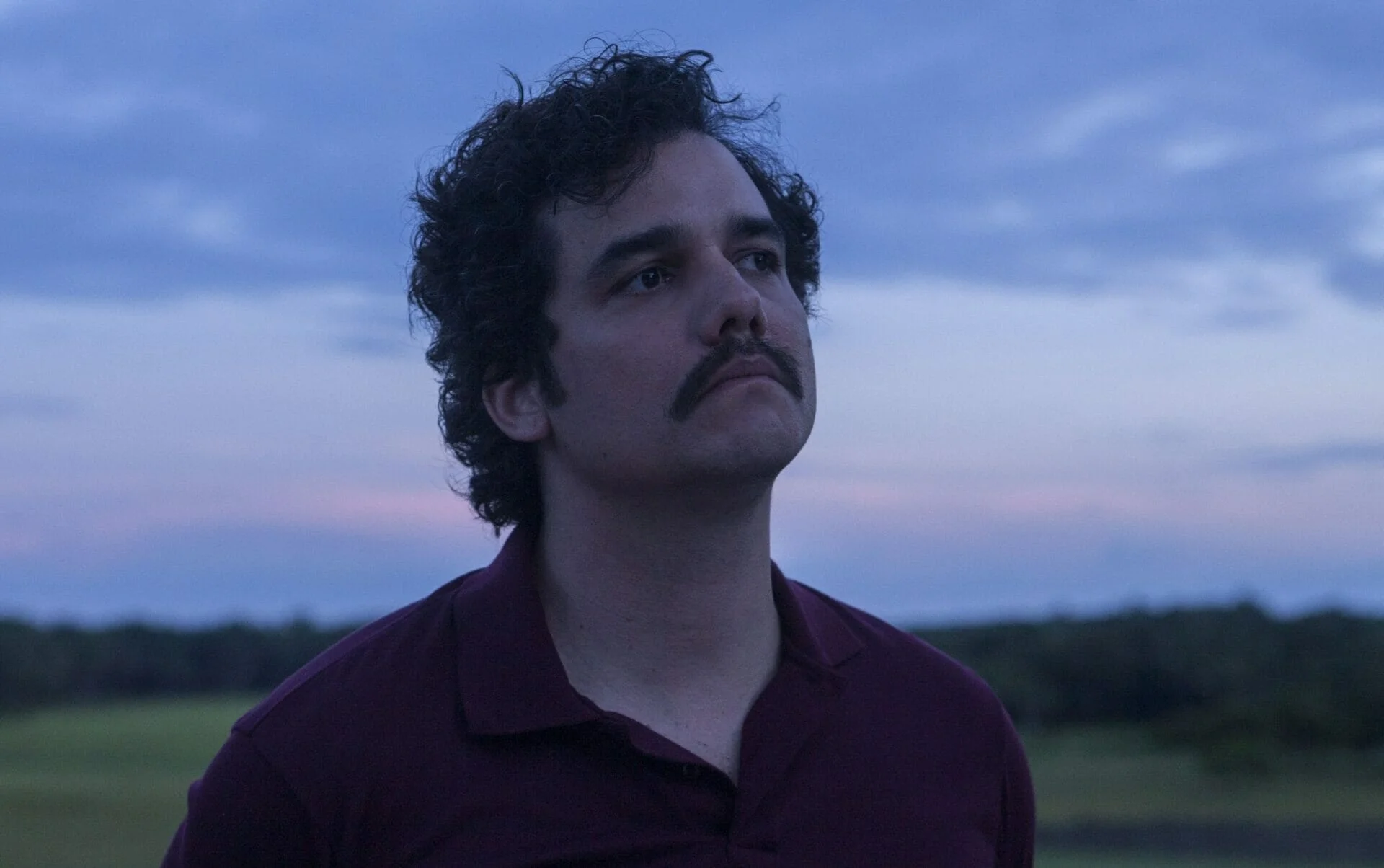
Maestro | A Portrait of a Marriage Away From the Spotlight
Year
Runtime
Director
Cinematographer
Production Designer
Music by
Country
Format
Subgenre
American composer, conductor, and pianist Leonard Bernstein is widely regarded as one of the most charismatic and gifted musicians of the 20th century. Actor and filmmaker Bradley Cooper pays tribute to the towering figure of Bernstein, re-reading and re-enacting his prodigious creative talent and the duality that pervaded his existence. Cooper brings this to life in his second directorial effort, Maestro. As he did with the musical romantic drama A Star is Born (2018), his acclaimed directorial debut, Cooper again produced, wrote (here two-handedly with Oscar-winning screenwriter John Singer), directed, and starred in Maestro.
This movie could appear as a traditional biopic that traces the professional life and masterpieces of a multifaceted musical genius. However, Cooper takes a more personal approach, focusing on the private, sympathetic, and previously unexplored life of the artist. Maestro focuses on Bernstein’s compulsions, desires, and tortured mind. The narration of Bernstein’s marriage to Felicia Montealegre (played by Carey Mulligan) allows his private life to transcend the celebrated artist’s career. As a result, his wife also comes into the spotlight, turning the story more into an intimate romantic drama.
Cooper’s meticulous, deep gaze results in a carefully detailed reconstruction, made realistic by sophisticated cinematic means. The changes from black-and-white to color, the different aspect ratios, the use of music, and the camera movements all contribute to crafting a romanticized portrait of two great artists.
Light and Darkness of a Two-Faced Musician
A work of art does not answer questions, it provokes them; and its essential meaning is in the tension between the contradictory answers.
Maestro opens with this quote from Leonard Bernstein (Bradley Cooper)
It’s 1943. Pianist and assistant conductor Leonard Bernstein (Cooper) lives off his music and an on-and-off affair with clarinetist David Oppenheim (Matt Bomer). He is only twenty-five when he makes his debut as conductor of the New York Philharmonic because the guest conductor is ill. His impromptu performance quickly catapults him to fame. After three years in New York, he meets Broadway actress Felicia Montealegre (Mulligan). They develop an instant chemistry but do not marry until many years later. Meanwhile, Bernstein’s professional success continues to grow. He creates many masterpieces in the fifties, including the musical West Side Story. Over time, however, the two faces of the composer emerge increasingly apparent.
Still, Maestro is above all the story of an extraordinary love that both Bernstein and Montelegre knew was real. Cooper creates a portrait of a difficult marriage: a balance of tenderness, care, patience, understanding, compassion, strength, and mutual support. A journey through a private and necessarily public lifelong relationship. Through euphoria and depression, through political commitment and alcohol and drug abuse, in sickness and in health. Till death do them part.

A Deep, Resilient Love
I knew that I didn’t want to make a biopic, but I also knew that if I put his music in the movie, then that would do everything that a biopic would ever do anyway.
Bradley Cooper interviewed for Variety
Though structured as a memoir, Maestro departs from the classic biopic from the outset. Since Bernstein spent his entire life in show business, the classic choice would have been to focus on his professional life. Cooper, however, opted for a more intimate story, following Bernstein’s marriage to Felicia and his intermittent affairs. At the beginning of the story, he’s in a homosexual relationship with a musician. When he moves to New York and meets Felicia, something sparks, but his tortured and passionate nature doesn’t allow him to be a fully committed husband.
The movie sheds light on the composer’s dual sentimental life and, as a result, his bisexuality. LGBTQI+ relationships and related social issues aren’t new themes for biopics or movies set in show business. Bernstein’s journey is similar (and in some ways opposite) to that of Freddie Mercury, as told by Bryan Singer in Bohemian Rhapsody (2018). The movie also deals with the stigma of HIV, as does Steven Levenson‘s Tick, Tick… Boom! (2021). But even this aspect is given a private shadow in Maestro, which focuses on the effects on the marriage. Bernstein’s bisexuality appears as one of the many aspects of his life and his dual personality. A never-denied passion that put the relationship to the test several times without being able to destroy it.
A Biopic With Two Protagonists
Giving almost equal narrative space to Felicia and Leonard, Maestro becomes a story with a couple as its protagonist. As a result, Felicia, far from being a secondary character, becomes the main protagonist of Maestro. Similar to Pablo Larraín‘s Jackie (2016), Maestro portrays a great woman beside a great man. From a narrative point of view, just as the interview with Jackie Kennedy becomes an excuse to talk about John F. Kennedy, Maestro gives more space to the professional and personal life of Felicia Montealegre. Both movies become a frame that contains two different biographies linked by a life lived together.
Mulligan’s outstanding performance brings to life a varied, towering character who proves to be the couple’s mainstay. As Leonard is torn apart, vacillating between enthusiasm and depression, Felicia is a steady anchor, and not just as a wife. An authentic and loyal companion, she remains by his side through the many hardships he faces as a musician. When the fear of failure and insecurities overwhelm him, Felicia proves to be a firm support for a fragile human being. But the movie also shows her growth as an artist and her life in the light of show business.
Framing the Intimacy of a Star
Cinematographer Matthew Libatique had previously worked with Cooper on A Star is Born. For Maestro, he wanted to be more experimental. After much experimentation, he finally settled on Kodak film with Panaflex Millennium XL cameras. The movie shifts from black-and-white to color palettes, and the aspect ratio changes throughout the story.
We wanted to first transport the audience into this time period of Lenny’s life in 1.33:1 black and white. When the story graduates into the 1970s, to mark the time period, we switched to color. Then, after Felicia dies, the film expands to 1.85:1. […] The 1.33:1 frame, because of its lack of left and right, feels like an embrace of these two people.
Matthew Libatique interviewed for Motion Picture Association
Cooper’s main goal was to show the touching, intimate story of a marriage. He always imagined the movie in black-and-white, but Libatique introduced the color, as well as the different aspect ratio. In the black-and-white scenes, the tight frame embraces the protagonists, making them seem closer. The bright gray tones evoke a nostalgic past, taking the viewers back to a dreamy time. When switching to color, the images are slightly grainy and less vivid to evoke the time in which the story is set. Both the visuals and the camera movements are reminiscent of a documentary style of filming in the past. Even the framing changes and the characters are shown from a distance, emphasizing their private dimension. After Felicia’s death, the aspect ratio becomes even wider to emphasize the man’s loneliness.

Each of Libatique’s technical choices helps the viewers immediately understand the time jumps as well as the emotional state. They all contribute to the reconstruction of a love story that Cooper intended. The initial aspect ratio recalls the cinematography of Felix Van Groeningen and Charlotte Vandermeersch‘s The Eight Mountains (2022). The latter, however, chose to emphasize the verticality and height of the mountains, while Libatique wanted the opposite. But the scene reaches its apogee of majesty during the concert in Ely Cathedral.
Picturing the Pinnacle of a Career
Leonard Bernstein conducted Gustav Mahler’s “Resurrection Symphony” (Symphony No. 2) at Ely Cathedral in 1973. The episode was condensed into a six-minute scene that is the major climax of Maestro. It was one of the most challenging not only for Libatique but also for Cooper. Classical music has always held a special place in the actor’s life, and as a child, he was so fascinated by conductors that he asked for a baton as a gift. He rejected the idea that someone else could play the piano or conduct the orchestra in his place. On the other hand, he didn’t want to imitate Bernstein’s original gestures, which would have been an empty endeavor. Nevertheless, he had a difficult time:
Unfortunately, the first day it was terrifying and it was horrendous because I kept messing up – and because we were doing it live. […] And then luckily, I think all the years of preparation and work paid off.
Bradley Cooper in an interview for Classic FM
In this particular scene, Cooper allows his artistic ego to explode, becoming a veritable “maestro” for his movie. He spent six years preparing for the scene, working with leading conductors Gustavo Dudamel and Yannick Nézet-Séguin, who stayed with him during the shoot. The result is a powerful and evocative shot, yet far removed from the real thing. Despite the supposedly true-to-life nature of a biopic, the director opted for a more spectacular (made possible by the cinematic medium), albeit fictional, reconstruction.
With exaggerated movements and extreme expressiveness, forgetting the serenity and elegance of Bernstein’s gestures, he conducted the 130 musicians of the London Symphony Orchestra. In fact, despite the will to recreate the original concert, the Cooper-Bernstein character lacks the authenticity and credibility for the most enthusiastic cinematic reinterpretation. For their part, the musicians had some difficulty understanding his gestures. According to one timpanist, the first attempt was “a total shit”. Then they brought a giant techno crane onto the set and the magic happened. After 90′ of non-stop shooting, Cooper explained: “My memory of that take was that I was actually floating above the orchestra and that I was able to point to each musician.”
The camera remains almost still, emphasizing the majesty of the cathedral, the orchestra, and its choir. Various framings and subtle movements allow the viewer’s gaze to wander over the musicians’ gestures and fully appreciate the music. Above all, Libatique’s choices emphasize Bernstein’s presence as a performer, with exaggerated movements and extreme expressiveness. The portrait of a man who truly found his source of life in music.
Who is the real Maestro?
Released on Netflix on December 20 after premiering at the 80th Venice International Film Festival, where it was in the running for the Golden Lion, Maestro counts among its producers none other than two giants of the film industry – Martin Scorsese and Steven Spielberg. Similarly to his protagonist, Cooper proved to be a true “maestro” as an actor, as well as a director. It is no coincidence that the movie received four nominations at the 81st Golden Globe Awards and seven nominations at the upcoming 96th Academy Awards, including Best Picture, Best Original Screenplay, Best Actor for Cooper, and Best Actress for Mulligan. Rounding out the accolades, the American Film Institute listed it as one of the 10 outstanding movies of 2023. Yet, as majestic as it longs to appear, the movie risks leaving no mark on cinema history. Except perhaps in the form of awards.
In Maestro, Cooper once again demonstrates his meticulous attention to detail. To match the composer’s appearance and his aging over the years, makeup artist Kazu Hiro also had him wear a prosthetic nose. His work was worthy of an Academy Award nomination for Best Makeup and Hairstyling, but the actor was accused of performing in “Jewface”. However, as The Guardian reported, the Anti-Defamation League said that the use of the prosthetic was merely a reconstruction of Bernstein’s real nose. Another significant detail is the soundtrack, which consists of Bernstein’s original compositions. As in Giuseppe Tornatore‘s Ennio (2021), they are the main biographical element and accompany the entire narrative. The music changes over time, blending private and public life and tracing the different aspects of Bernstein’s professional life.
Every detail contributes to the director’s decision to make a very unusual biopic that becomes a delicate investigation into the nature of marriage. Similar to Noah Baumbach‘s Scenes from a Marriage (2021), the movie tries to discover what constitutes a solid basis for a love life. Through the analysis of the couple, Bernstein appears in his most human, and tormented aspects. A man full of inner conflicts, that echo in every aspect of his nature: public and private life, pop and cultured music, fluid sexuality, euphoria, and depression. This duality mirrors itself in the coexistence of two infinite loves: Felicia and music. As he explains, she would have stayed with him forever, but his music gave him a reason to exist.
Tag
Buy a ☕ for Hypercritic








